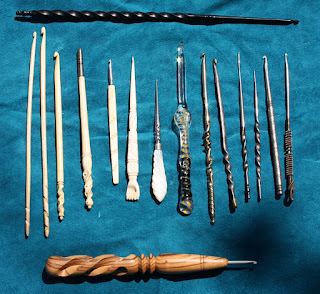Here is my pattern for Wink2 Tribute. It is a mandala I designed, using Marinke's design elements into my own original design. I made it to be part of Kathryn Vercillo's Mandalas for Marinke Project to honor Marinke's life and to raise awareness about depression. See: http://www.crochetconcupiscence.com/2015/06/mandalasformarinke-crochet-project-in-memory-of-wink-from-a-creative-being/ for more details. I am offering this free pattern especially for those of you who may like to use it for Kathryn's project. Feel free to contact e if you have any difficulties with it.
Crochet Hook: I used a U.S G-6/4mm because I like tight
work. However, the yarn I used
recommended a 5mm (U.S. 8) and it might be easier to use a larger hook than the
one I used. This should not matter for
the Mandalas for Marinke Project since a mandala size was not specified.
Yarn: I used
Paris Drops, a loosely plied 100% cotton that was Wink’s favorite yarn.
Colors Used:
Color A = strong yellow #14 (for center of
center flower and sun rays)
Color B = vanilla (light yellow) #35 (for
cluster-petals of center flower)
Color C = opal green #11 (for stems and
leaves)
Color D = white #16 (for fence)
Color E = hot pink #06 (for blossom
clusters)
Color F = dark turquoise #10 (for sky
edging)
Color G = red #12 (for heart)
Sewing thread in color G, Darning needle, Sewing needle, and
Scissors
Rnd 1: Using color A,
ch 2, 8 dc in 1st ch, sl st in 1st dc; finish off.
Rnd 2: Using color B,
(dc 4, sl st in back of 1st dc, [cluster made], ch 3) around, sl st
in top of 1st cluster; finish off (8 clusters).
Rnd 3: Using color C,
(sc 4 in ch-3 sp {between clusters}) around, sl st in 1st sc; finish
off (32 sc’s).
Rnd 4: Using color D, attach yarn above one cluster, (sc 2,
long sc into space below 3rd-Rnd {between next two clusters}, sc in
next2 sts) around, sl st in 1st sc; finish off (40 sc’s).
Rnd 5: Using color C,
working in back: (trc in 3rd-Rnd before a cluster, ch 2, trc after
the cluster, ch 5) around, sl st in 1st trc; finish off (16 trc’s).
Rnd 6: Using color E, (4 dc in ch-2-sp, sl st in back of 1st
dc [cluster made], ch 8) around, sl st in top of 1st cluster; finish
off (8 clusters).
Rnd 7: Using color D,
(sc 5 in ch-8-sp; ch 2, sl st in 1st
ch [picot made]; dtrc in 4th-Rnd-long-sc
[spoke made], sc 5 in same ch-8-sp) around, sl st in 1st sc; finish
off (8 spokes topped with picots).
Rnd 8: Using color A,
working in back loops only: dc on one side of a picot, (ch, dc on the other
side of picot, ch, sk 1, dc, ch, sk 1, dc over closest side of cluster, ch, dc,
ch, sk 1, dc, ch, sk1,dc on closest side of picot) around, sl st in 1st
dc; finish off (48 dc’s).
Rnd 9: Using color
F, starting between 2-dcs-above-spoke
(dc 2 in next ch-1-sp, dc 3 in next ch-1-sp) around, sl st in 1st
dc; DON’T FINISH OFF (120 dc’s).
RND 10: Continuing
with color F, sc in same st as sl-st, (sk 3, dc 6 in next st, sk 2, sc {directly above 6th-
Rnd-cluster}
[1st fan made]; sk 3, dc 6 in next st, sk 3, sc {directly above 7th-Rnd-picot}
[2nd fan made]) around—ending with sl st in first sc; finish off (16
fans).
HEART: Using color G,
ch 6, dc in 3rd ch, sl st in same ch, ch 2, trc in same ch, ch 2 ,
sl st in 2nd ch of foundation-ch, finish off. Weave tail through 1st ch of foundation-ch
and up one side of heart and down the back-middle, weave other tail up other
side of heart and down back-middle. Using sewing thread, tack heart to center
of mandala.













.jpg)
.jpg)






.jpg)
